

| Solar eclipse of November 3, 2013 | |
|---|---|
Partial from Libreville, Gabon
| |
| Type of eclipse | |
| Nature | Hybrid |
| Gamma | 0.3272 |
| Magnitude | 1.0159 |
| Maximum eclipse | |
| Duration | 100 s (1 min 40 s) |
| Coordinates | 3°30′N 11°42′W / 3.5°N 11.7°W / 3.5; -11.7 |
| Max. width of band | 58 km (36 mi) |
| Times (UTC) | |
| (P1) Partial begin | 10:04:34 |
| (U1) Total begin | 11:05:17 |
| Greatest eclipse | 12:47:36 |
| (U4) Total end | 14:27:42 |
| (P4) Partial end | 15:28:21 |
| References | |
| Saros | 143 (23 of 72) |
| Catalog # (SE5000) | 9538 |
A total solar eclipse occurred at the Moon's ascending node of orbit on Sunday, November 3, 2013,[1][2][3] with a magnitude of 1.0159. It was a hybrid eclipse of the Sun with a small portion over the western Atlantic Ocean at sunrise as an annular eclipse and the rest of the path as a narrow total solar eclipse. A solar eclipse occurs when the Moon passes between Earth and the Sun, thereby totally or partly obscuring the image of the Sun for a viewer on Earth. A hybrid solar eclipse occurs when the Moon's apparent diameter is smaller than the Sun's in sunrise and sunset, but at Greatest Eclipse the Moon's apparent diameter is larger than the Sun's.
In this particular case the eclipse path starts out as annular and ends as total.
It was the 23rd eclipse of the 143rd Saros cycle, which began with a partial eclipse on March 7, 1617, and will conclude with a partial eclipse on April 23, 2897.
Totality was visible from the northern Atlantic Ocean (east of Florida) to Africa (Gabon (landfall), R. Congo, DR Congo, Uganda, South Sudan, Kenya, Ethiopia, Somalia), with a maximum duration of totality of 1 minute and 39 seconds, visible from the Atlantic Ocean south of Ivory Coast and Ghana.[4]
Places with partial darkening were the Eastern coast of North America, southern Greenland, Bermuda, the Caribbean islands, Costa Rica, Panama, Northern South America, almost all the African continent, the Iberian Peninsula, Italy, Greece, Malta, Southern Russia, the Caucasus, Turkey and the Middle East.
This solar eclipse happened simultaneously with the 2013 Abu Dhabi Grand Prix, and it was possible to observe a partial solar eclipseinAbu Dhabi before the sunset while the F1 race took place, as shown briefly during its broadcast.[5]
This eclipse is a member of the 2011–2014 solar eclipse semester series. An eclipse in a semester series of solar eclipses repeats approximately every 177 days and 4 hours (a semester) at alternating nodes of the Moon's orbit.[6][Note 1]
| Descending node | Ascending node | |||||
|---|---|---|---|---|---|---|
| Saros | Map | Gamma | Saros | Map | Gamma | |
118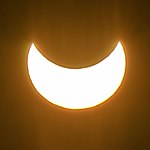 Partial from Tromsø, Norway |
2011 June 01 Partial (north) |
1.21300 | 123 Hinode XRT footage |
2011 November 25 Partial (south) |
−1.05359 | |
128 Middlegate, Nevada |
2012 May 20 Annular |
0.48279 | 133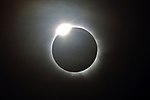 Cairns, Australia |
2012 November 13 Total |
−0.37189 | |
138 Churchills Head, Australia |
2013 May 10 Annular |
−0.26937 | 143 Partial from Libreville, Gabon |
2013 November 03 Hybrid |
0.32715 | |
148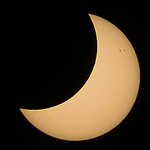 Partial from Adelaide, Australia |
2014 April 29 Annular (non-central) |
−0.99996 | 153 Partial from Minneapolis |
2014 October 23 Partial (north) |
1.09078 | |
It is a part of Saros cycle 143, repeating every 18 years, 11 days, containing 72 events. The series started with partial solar eclipse on March 7, 1617 and total event from June 24, 1797 through October 24, 1995. It has hybrid eclipses from November 3, 2013 through December 6, 2067, and annular eclipses from December 16, 2085 through September 16, 2536. The series ends at member 72 as a partial eclipse on April 23, 2873. The longest duration of totality was 3 minutes, 50 seconds on August 19, 1887. All eclipses in this series occurs at the Moon’s ascending node.
| Series members 17–28 occur between 1741 and 2100 | ||
|---|---|---|
| 8 | 9 | 10 |
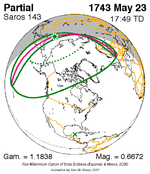 May 23, 1743 |
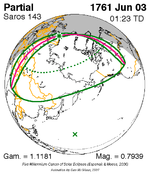 June 3, 1761 |
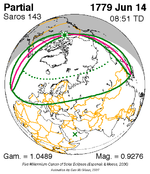 June 14, 1779 |
| 11 | 12 | 13 |
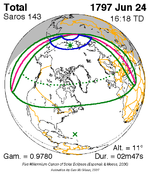 June 24, 1797 |
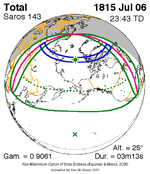 July 6, 1815 |
 July 17, 1833 |
| 14 | 15 | 16 |
 July 28, 1851 |
 August 7, 1869 |
 August 19, 1887 |
| 17 | 18 | 19 |
 August 30, 1905 |
 September 10, 1923 |
 September 21, 1941 |
| 20 | 21 | 22 |
 October 2, 1959 |
 October 12, 1977 |
 October 24, 1995 |
| 23 | 24 | 25 |
 November 3, 2013 |
 November 14, 2031 |
 November 25, 2049 |
| 26 | 27 | 28 |
 December 6, 2067 |
 December 16, 2085 | |
This eclipse is a part of a tritos cycle, repeating at alternating nodes every 135 synodic months (≈ 3986.63 days, or 11 years minus 1 month). Their appearance and longitude are irregular due to a lack of synchronization with the anomalistic month (period of perigee), but groupings of 3 tritos cycles (≈ 33 years minus 3 months) come close (≈ 434.044 anomalistic months), so eclipses are similar in these groupings.
| Series members between 1901 and 2100 | |||
|---|---|---|---|
 September 9, 1904 (Saros 133) |
 August 10, 1915 (Saros 134) |
 July 9, 1926 (Saros 135) | |
 June 8, 1937 (Saros 136) |
 May 9, 1948 (Saros 137) |
 April 8, 1959 (Saros 138) | |
 March 7, 1970 (Saros 139) |
 February 4, 1981 (Saros 140) |
 January 4, 1992 (Saros 141) | |
 December 4, 2002 (Saros 142) |
 November 3, 2013 (Saros 143) |
 October 2, 2024 (Saros 144) | |
 September 2, 2035 (Saros 145) |
 August 2, 2046 (Saros 146) |
 July 1, 2057 (Saros 147) | |
 May 31, 2068 (Saros 148) |
 May 1, 2079 (Saros 149) |
 March 31, 2090 (Saros 150) | |
This eclipse is a part of the long period inex cycle, repeating at alternating nodes, every 358 synodic months (≈ 10,571.95 days, or 29 years minus 20 days). Their appearance and longitude are irregular due to a lack of synchronization with the anomalistic month (period of perigee). However, groupings of 3 inex cycles (≈ 87 years minus 2 months) comes close (≈ 1,151.02 anomalistic months), so eclipses are similar in these groupings.
| Inex series members between 1901 and 2100: | ||
|---|---|---|
 January 3, 1927 (Saros 140) |
 December 14, 1955 (Saros 141) |
 November 22, 1984 (Saros 142) |
 November 3, 2013 (Saros 143) |
 October 14, 2042 (Saros 144) |
 September 23, 2071 (Saros 145) |
 September 4, 2100 (Saros 146) |
||
The metonic series repeats eclipses every 19 years (6939.69 days), lasting about 5 cycles. Eclipses occur in nearly the same calendar date. In addition, the octon subseries repeats 1/5 of that or every 3.8 years (1387.94 days). All eclipses in this table occur at the Moon's ascending node.
| 21 eclipse events, progressing from south to north between June 10, 1964, and August 21, 2036 | ||||
|---|---|---|---|---|
| June 10–11 | March 27–29 | January 15–16 | November 3 | August 21–22 |
| 117 | 119 | 121 | 123 | 125 |
 June 10, 1964 |
 March 28, 1968 |
 January 16, 1972 |
 November 3, 1975 |
 August 22, 1979 |
| 127 | 129 | 131 | 133 | 135 |
 June 11, 1983 |
 March 29, 1987 |
 January 15, 1991 |
 November 3, 1994 |
 August 22, 1998 |
| 137 | 139 | 141 | 143 | 145 |
 June 10, 2002 |
 March 29, 2006 |
 January 15, 2010 |
 November 3, 2013 |
 August 21, 2017 |
| 147 | 149 | 151 | 153 | 155 |
 June 10, 2021 |
 March 29, 2025 |
 January 14, 2029 |
 November 3, 2032 |
 August 21, 2036 |